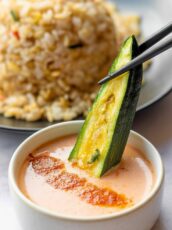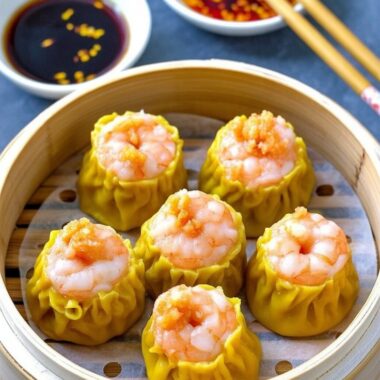If you’re craving something bold, fresh, and ridiculously easy to whip up, this spicy tuna recipe has your back. Whether you’re piling it onto crispy rice, rolling it into sushi, or scooping it into a rice bowl, it’s the kind of no-cook dish that delivers serious flavor in just minutes.
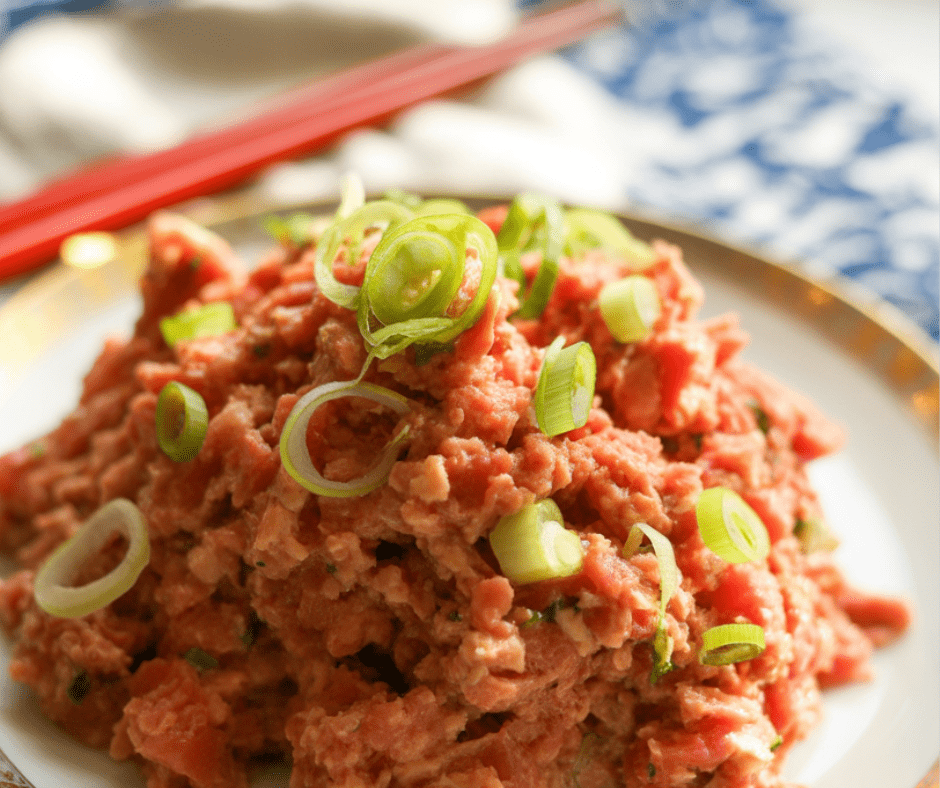
What is Spicy Tuna?
Spicy tuna is that creamy, punchy mix you’ve probably had in sushi rolls or spicy tuna bowls at your favorite Japanese spot. It’s made with sashimi-grade tuna, spicy mayo, and a few pantry staples—no cooking needed. It’s cool, fiery, rich, and incredibly versatile.
At home, I love serving it with nori sheets and soy sauce, maybe some rice and sliced avocado. Or I’ll load it onto crispy rice for a restaurant-style appetizer. If raw tuna’s not your thing (or it’s hard to get), don’t worry—I’ll share a canned tuna version too that’s equally delicious.
Ingredients and Substitutions
Sashimi-Grade Tuna Steaks:
If you’re using raw tuna, always go for sushi- or sashimi-grade. That means it’s been flash-frozen to kill any unwanted stuff and is safe to eat raw. Don’t be put off if it comes frozen—that’s totally normal. Fun tip: Aldi often has frozen sushi-grade tuna at a great price!
If raw tuna isn’t available or in your comfort zone, you can absolutely use canned tuna. The texture and experience change, but it turns into a spicy tuna salad that’s just as satisfying.
Japanese Kewpie Mayo:
This mayo is creamier and richer than the regular kind, made with egg yolks instead of whole eggs. It’s key to the silky texture of spicy tuna. You’ll find it online or in the Asian aisle of most grocery stores.
Sesame Oil:
Nutty and aromatic, sesame oil adds depth. It’s not the same if you swap it out, so definitely use the real thing.
Crispy Chili Oil:
A crunchy, spicy upgrade I picked up from a local Japanese joint. It adds both heat and texture. No crispy chili oil? Just double the sriracha.
Sriracha:
Classic, fiery, tangy. It’s the heat in this recipe. Adjust based on your spice tolerance—start small and build it up.
Flaky Salt:
A little goes a long way in lifting all the flavors. Use sea salt or kosher salt if that’s what you have.
Scallions:
Optional, but I love the bite and color they add. Especially when you’re serving spicy tuna on its own or on crispy rice.
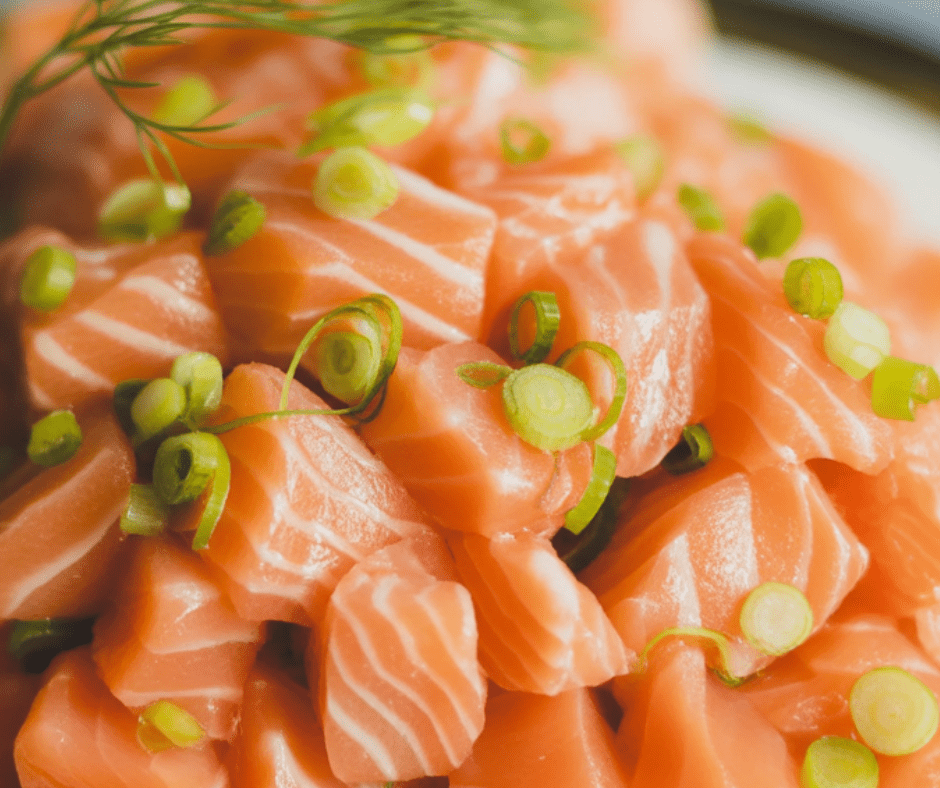
How to Make It
Step 1: Prep the Fish
If you’re using raw tuna, rinse it quickly under cold water and pat it dry. This removes any extra oiliness. Then, using your sharpest knife, dice it into tiny cubes—about ¼ inch. You want a fine mince with a little texture left.
Step 2: Mix the Flavorings
Add the tuna to a mixing bowl. Stir in the Kewpie mayo, sesame oil, chili oil, sriracha, and a pinch of flaky salt.
Step 3: Combine
Gently stir until the tuna is evenly coated. Give it a taste—add more salt or spice if needed. That’s it. From here, it’s ready to go in bowls, rolls, or whatever you’ve got planned.
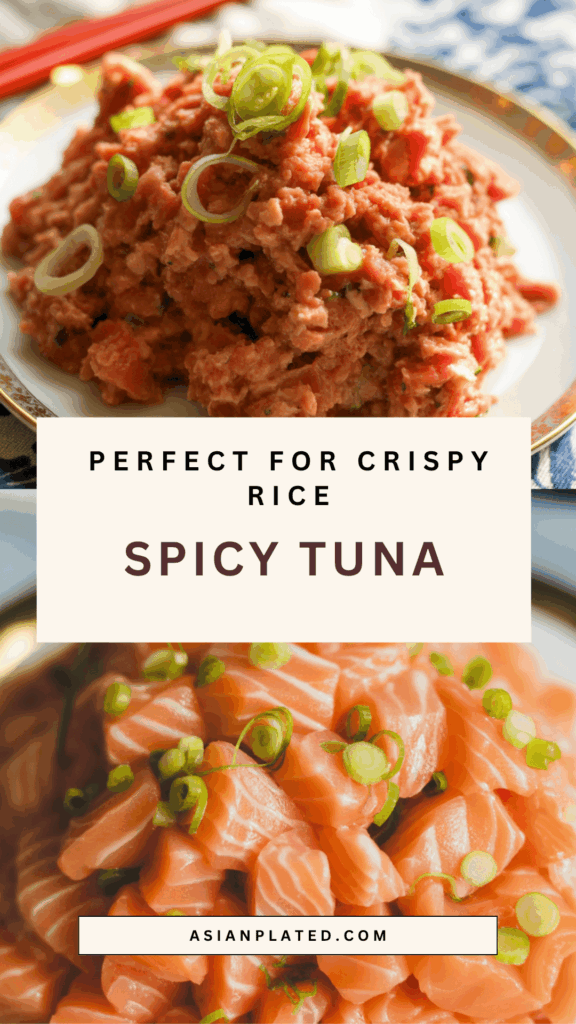
Ways to Serve Spicy Tuna
Spicy Tuna Bowl
This is my go-to lazy lunch. Start with warm sushi rice (or any cooked rice), then top with spicy tuna, sliced avocado, seaweed salad, sesame seeds, and scallions. A little drizzle of soy sauce or wasabi on the side, and you’re good to go.
Pro tip: For sushi-style rice, stir in a bit of rice vinegar after cooking—it gives that signature sticky texture.
Sushi Roll or Hand Roll
If you’re rolling sushi at home, spicy tuna is a must. Grab a nori sheet, spread a layer of sushi rice (wet your fingers to avoid sticking), add a strip of spicy tuna, maybe some cucumber or avocado, and roll it up tight.
Use a bamboo mat if you have one. If not, plastic wrap works in a pinch. Slice and serve with soy sauce, wasabi, and pickled ginger.
Crispy Rice
These are addictive little bites—crispy on the outside, soft inside, and topped with creamy spicy tuna. Think restaurant-quality but made right in your kitchen. If you want to try it, check out my crispy rice method—it’s totally worth the effort for parties or date night.
Inari (Stuffed Tofu Pockets)
This one’s a personal favorite. I get inari pockets from the Asian market—they’re sweet, vinegary tofu pouches. I fill them with sushi rice, a spoonful of spicy tuna, and then top with unagi sauce, spicy mayo, scallions, and roe if I’ve got it on hand. Sweet, savory, and a total flavor bomb.
How to Store Spicy Tuna
If you’re using raw tuna, I recommend making it right before serving. Raw fish tends to lose its texture and flavor quickly once mixed, and I personally think it’s best fresh.
But if you’re using canned tuna? You can prep the mixture a day in advance and store it in an airtight container in the fridge. It actually gets better as it sits and soaks in the flavors.
Spicy Tuna

This quick and easy spicy tuna recipe is ideal for using as a topping or filling for crispy rice, sushi rolls, or grain bowls. It's a no-cook, Japanese-inspired dish that comes together in just a few minutes with a handful of ingredients.
Ingredients
- 12 oz sashimi-grade tuna steaks (about 2–3 small steaks)
- 2 tbsp Kewpie (Japanese mayonnaise)
- 1 tsp sesame oil
- ½ tsp crispy chili oil
- 1 tsp sriracha
- ⅛ tsp flaky sea salt
- 1 tbsp finely sliced scallions
Instructions
Rinse the tuna steaks under cool water and pat them dry. Using your sharpest knife, dice the tuna into small ¼-inch cubes—or mince roughly until it reaches a coarse texture.
In a bowl, combine the chopped tuna with Kewpie mayo, sesame oil, chili oil, sriracha, and a pinch of flaky salt.
Mix until well combined. Use immediately as a filling for sushi rolls, bowls, or crispy rice. Top with scallions and serve alongside sushi rice and nori, if desired.
Nutrition Information:
Yield: 2 Serving Size: 1Amount Per Serving: Calories: 336Total Fat: 11gSaturated Fat: 2gTrans Fat: 0gUnsaturated Fat: 8gCholesterol: 184mgSodium: 505mgCarbohydrates: 2gFiber: 0gSugar: 1gProtein: 53g
Asianplated.com, occasionally offers nutritional information for recipes contained on this site. This information is provided as a courtesy and is an estimate only. This information comes from online calculators. Although allchickenrecipes.com attempts to provide accurate nutritional information, these figures are only estimates.
FAQs
Can I use canned tuna instead of raw tuna?
Absolutely. Just make sure to drain it well. It turns this into more of a spicy tuna salad, but it’s still amazing on rice bowls, toast, or in lettuce wraps.
Is Kewpie mayo necessary?
It really elevates the flavor, but if you only have regular mayo, go ahead and use it. Add a small dash of rice vinegar or a pinch of sugar to mimic Kewpie’s slightly sweet taste.
Is it safe to eat raw tuna at home?
Yes, as long as it’s labeled “sushi grade” or “sashimi grade” and comes from a trusted source. Always store it cold and use it fresh.
What’s a good substitute for sriracha?
Chili garlic sauce or sambal oelek work great. Or you can skip it if you’re not a fan of heat.
That’s everything you need to make one of my favorite no-cook meals. Whether you’re in the mood for a sushi night, a cozy rice bowl, or just a snack on crispy rice, this spicy tuna mix is versatile, bold, and a total crowd-pleaser. Give it a try and let me know how you serve it—I’m always curious to hear your twist.
Try other recipes:



